[English] 日本語
 Yorodumi
Yorodumi- PDB-6e3y: Cryo-EM structure of the active, Gs-protein complexed, human CGRP... -
+ Open data
Open data
- Basic information
Basic information
| Entry | Database: PDB / ID: 6e3y | |||||||||
|---|---|---|---|---|---|---|---|---|---|---|
| Title | Cryo-EM structure of the active, Gs-protein complexed, human CGRP receptor | |||||||||
 Components Components |
| |||||||||
 Keywords Keywords | SIGNALING PROTEIN / class B G protein-coupled receptor / agonist-receptor-G protein ternary complex / calcitonin gene-related peptide receptor / receptor activity modifying protein 1 / active-state G protein-coupled receptor / phase plate / phase contrast | |||||||||
| Function / homology |  Function and homology information Function and homology informationnervous system process involved in regulation of systemic arterial blood pressure / calcitonin gene-related peptide binding / cellular response to sucrose stimulus / adrenomedullin binding / CGRP receptor complex / adrenomedullin receptor activity / adrenomedullin receptor complex / : / adrenomedullin receptor signaling pathway / amylin receptor activity ...nervous system process involved in regulation of systemic arterial blood pressure / calcitonin gene-related peptide binding / cellular response to sucrose stimulus / adrenomedullin binding / CGRP receptor complex / adrenomedullin receptor activity / adrenomedullin receptor complex / : / adrenomedullin receptor signaling pathway / amylin receptor activity / calcitonin receptor activity / calcitonin gene-related peptide receptor signaling pathway / vascular associated smooth muscle cell proliferation / calcitonin gene-related peptide receptor activity / positive regulation of interleukin-1 alpha production / negative regulation of calcium ion transport into cytosol / amylin receptor 1 signaling pathway / amylin receptor signaling pathway / positive regulation of macrophage differentiation / Calcitonin-like ligand receptors / regulation of G protein-coupled receptor signaling pathway / vasculature development / G protein-coupled receptor internalization / endothelial cell proliferation / negative regulation of bone resorption / leukocyte cell-cell adhesion / negative regulation of osteoclast differentiation / PKA activation in glucagon signalling / developmental growth / hair follicle placode formation / G protein-coupled receptor signaling pathway, coupled to cyclic nucleotide second messenger / D1 dopamine receptor binding / regulation of cytosolic calcium ion concentration / intracellular transport / endothelial cell migration / vascular endothelial cell response to laminar fluid shear stress / renal water homeostasis / activation of adenylate cyclase activity / Hedgehog 'off' state / cellular response to hormone stimulus / coreceptor activity / positive regulation of vascular associated smooth muscle cell proliferation / adenylate cyclase-activating adrenergic receptor signaling pathway / negative regulation of blood pressure / cellular response to glucagon stimulus / regulation of insulin secretion / adenylate cyclase activator activity / trans-Golgi network membrane / protein localization to plasma membrane / positive regulation of interleukin-8 production / intracellular protein transport / negative regulation of inflammatory response to antigenic stimulus / hormone activity / bone development / G protein-coupled receptor activity / receptor internalization / platelet aggregation / regulation of blood pressure / cognition / vasodilation / G-protein beta/gamma-subunit complex binding / adenylate cyclase-activating G protein-coupled receptor signaling pathway / Olfactory Signaling Pathway / Activation of the phototransduction cascade / G beta:gamma signalling through PLC beta / Presynaptic function of Kainate receptors / Thromboxane signalling through TP receptor / G protein-coupled acetylcholine receptor signaling pathway / Activation of G protein gated Potassium channels / Inhibition of voltage gated Ca2+ channels via Gbeta/gamma subunits / G-protein activation / Prostacyclin signalling through prostacyclin receptor / G beta:gamma signalling through CDC42 / Glucagon signaling in metabolic regulation / G beta:gamma signalling through BTK / Synthesis, secretion, and inactivation of Glucagon-like Peptide-1 (GLP-1) / ADP signalling through P2Y purinoceptor 12 / photoreceptor disc membrane / Sensory perception of sweet, bitter, and umami (glutamate) taste / Glucagon-type ligand receptors / Adrenaline,noradrenaline inhibits insulin secretion / Vasopressin regulates renal water homeostasis via Aquaporins / sensory perception of smell / Glucagon-like Peptide-1 (GLP1) regulates insulin secretion / G alpha (z) signalling events / calcium ion transport / cellular response to catecholamine stimulus / ADP signalling through P2Y purinoceptor 1 / ADORA2B mediated anti-inflammatory cytokines production / G beta:gamma signalling through PI3Kgamma / Cooperation of PDCL (PhLP1) and TRiC/CCT in G-protein beta folding / adenylate cyclase-activating dopamine receptor signaling pathway / GPER1 signaling / cell-cell signaling / G-protein beta-subunit binding / cellular response to prostaglandin E stimulus / Inactivation, recovery and regulation of the phototransduction cascade / heterotrimeric G-protein complex / G alpha (12/13) signalling events / sensory perception of taste Similarity search - Function | |||||||||
| Biological species |   Homo sapiens (human) Homo sapiens (human) | |||||||||
| Method | ELECTRON MICROSCOPY / single particle reconstruction / cryo EM / Resolution: 3.3 Å | |||||||||
 Authors Authors | Liang, Y.L. / Khoshouei, M. / Deganutti, G. / Glukhova, A. / Koole, C. / Peat, T.S. / Radjainia, M. / Plitzko, J.M. / Baumeister, W. / Miller, L.J. ...Liang, Y.L. / Khoshouei, M. / Deganutti, G. / Glukhova, A. / Koole, C. / Peat, T.S. / Radjainia, M. / Plitzko, J.M. / Baumeister, W. / Miller, L.J. / Hay, D.L. / Christopoulos, A. / Reynolds, C.A. / Wootten, D. / Sexton, P.M. | |||||||||
| Funding support |  Australia, 2items Australia, 2items
| |||||||||
 Citation Citation |  Journal: Nature / Year: 2018 Journal: Nature / Year: 2018Title: Cryo-EM structure of the active, G-protein complexed, human CGRP receptor. Authors: Yi-Lynn Liang / Maryam Khoshouei / Giuseppe Deganutti / Alisa Glukhova / Cassandra Koole / Thomas S Peat / Mazdak Radjainia / Jürgen M Plitzko / Wolfgang Baumeister / Laurence J Miller / ...Authors: Yi-Lynn Liang / Maryam Khoshouei / Giuseppe Deganutti / Alisa Glukhova / Cassandra Koole / Thomas S Peat / Mazdak Radjainia / Jürgen M Plitzko / Wolfgang Baumeister / Laurence J Miller / Deborah L Hay / Arthur Christopoulos / Christopher A Reynolds / Denise Wootten / Patrick M Sexton /         Abstract: Calcitonin gene-related peptide (CGRP) is a widely expressed neuropeptide that has a major role in sensory neurotransmission. The CGRP receptor is a heterodimer of the calcitonin receptor-like ...Calcitonin gene-related peptide (CGRP) is a widely expressed neuropeptide that has a major role in sensory neurotransmission. The CGRP receptor is a heterodimer of the calcitonin receptor-like receptor (CLR) class B G-protein-coupled receptor and a type 1 transmembrane domain protein, receptor activity-modifying protein 1 (RAMP1). Here we report the structure of the human CGRP receptor in complex with CGRP and the G-protein heterotrimer at 3.3 Å global resolution, determined by Volta phase-plate cryo-electron microscopy. The receptor activity-modifying protein transmembrane domain sits at the interface between transmembrane domains 3, 4 and 5 of CLR, and stabilizes CLR extracellular loop 2. RAMP1 makes only limited direct contact with CGRP, consistent with its function in allosteric modulation of CLR. Molecular dynamics simulations indicate that RAMP1 provides stability to the receptor complex, particularly in the positioning of the extracellular domain of CLR. This work provides insights into the control of G-protein-coupled receptor function. | |||||||||
| History |
|
- Structure visualization
Structure visualization
| Movie |
 Movie viewer Movie viewer |
|---|---|
| Structure viewer | Molecule:  Molmil Molmil Jmol/JSmol Jmol/JSmol |
- Downloads & links
Downloads & links
- Download
Download
| PDBx/mmCIF format |  6e3y.cif.gz 6e3y.cif.gz | 232.5 KB | Display |  PDBx/mmCIF format PDBx/mmCIF format |
|---|---|---|---|---|
| PDB format |  pdb6e3y.ent.gz pdb6e3y.ent.gz | 177.3 KB | Display |  PDB format PDB format |
| PDBx/mmJSON format |  6e3y.json.gz 6e3y.json.gz | Tree view |  PDBx/mmJSON format PDBx/mmJSON format | |
| Others |  Other downloads Other downloads |
-Validation report
| Arichive directory |  https://data.pdbj.org/pub/pdb/validation_reports/e3/6e3y https://data.pdbj.org/pub/pdb/validation_reports/e3/6e3y ftp://data.pdbj.org/pub/pdb/validation_reports/e3/6e3y ftp://data.pdbj.org/pub/pdb/validation_reports/e3/6e3y | HTTPS FTP |
|---|
-Related structure data
| Related structure data |  8978MC M: map data used to model this data C: citing same article ( |
|---|---|
| Similar structure data |
- Links
Links
- Assembly
Assembly
| Deposited unit | 
|
|---|---|
| 1 |
|
- Components
Components
-Calcitonin gene-related peptide ... , 2 types, 2 molecules PR
| #1: Protein/peptide | Mass: 3795.354 Da / Num. of mol.: 1 / Fragment: residues 83-119 / Source method: obtained synthetically / Source: (synth.)  Homo sapiens (human) / References: UniProt: P06881 Homo sapiens (human) / References: UniProt: P06881 |
|---|---|
| #6: Protein | Mass: 56274.520 Da / Num. of mol.: 1 Source method: isolated from a genetically manipulated source Source: (gene. exp.)  Homo sapiens (human) / Gene: CALCRL, CGRPR / Production host: Homo sapiens (human) / Gene: CALCRL, CGRPR / Production host:  Trichoplusia ni (cabbage looper) / References: UniProt: Q16602 Trichoplusia ni (cabbage looper) / References: UniProt: Q16602 |
-Guanine nucleotide-binding protein ... , 3 types, 3 molecules ABG
| #3: Protein | Mass: 45683.434 Da / Num. of mol.: 1 Mutation: N54S, A226G, A268E, K271N, D274K, K280R, D284T, T285I Source method: isolated from a genetically manipulated source Source: (gene. exp.)  Homo sapiens (human) / Gene: GNAS, GNAS1, GSP / Production host: Homo sapiens (human) / Gene: GNAS, GNAS1, GSP / Production host:  Trichoplusia ni (cabbage looper) / References: UniProt: P63092 Trichoplusia ni (cabbage looper) / References: UniProt: P63092 |
|---|---|
| #4: Protein | Mass: 38534.062 Da / Num. of mol.: 1 Source method: isolated from a genetically manipulated source Source: (gene. exp.)  Homo sapiens (human) / Gene: GNB1 / Production host: Homo sapiens (human) / Gene: GNB1 / Production host:  Trichoplusia ni (cabbage looper) / References: UniProt: P62873 Trichoplusia ni (cabbage looper) / References: UniProt: P62873 |
| #5: Protein | Mass: 7861.143 Da / Num. of mol.: 1 Source method: isolated from a genetically manipulated source Source: (gene. exp.)  Homo sapiens (human) / Gene: GNG2 / Production host: Homo sapiens (human) / Gene: GNG2 / Production host:  Trichoplusia ni (cabbage looper) / References: UniProt: P59768 Trichoplusia ni (cabbage looper) / References: UniProt: P59768 |
-Antibody / Protein , 2 types, 2 molecules NE
| #2: Antibody | Mass: 15140.742 Da / Num. of mol.: 1 Source method: isolated from a genetically manipulated source Source: (gene. exp.)   |
|---|---|
| #7: Protein | Mass: 17066.701 Da / Num. of mol.: 1 Source method: isolated from a genetically manipulated source Source: (gene. exp.)  Homo sapiens (human) / Gene: RAMP1 / Production host: Homo sapiens (human) / Gene: RAMP1 / Production host:  Trichoplusia ni (cabbage looper) / References: UniProt: O60894 Trichoplusia ni (cabbage looper) / References: UniProt: O60894 |
-Details
| Has protein modification | Y |
|---|
-Experimental details
-Experiment
| Experiment | Method: ELECTRON MICROSCOPY |
|---|---|
| EM experiment | Aggregation state: PARTICLE / 3D reconstruction method: single particle reconstruction |
- Sample preparation
Sample preparation
| Component | Name: Complex of a full-length, active-state calcitonin gene-related peptide receptor with calcitonin gene-related peptide ligand, heterotrimeric Gs protein and nanobody35 Type: COMPLEX / Entity ID: all / Source: RECOMBINANT |
|---|---|
| Molecular weight | Experimental value: NO |
| Source (natural) | Organism:  Homo sapiens (human) Homo sapiens (human) |
| Source (recombinant) | Organism:  Trichoplusia ni (cabbage looper) Trichoplusia ni (cabbage looper) |
| Buffer solution | pH: 7.4 |
| Specimen | Embedding applied: NO / Shadowing applied: NO / Staining applied: NO / Vitrification applied: YES |
| Specimen support | Grid material: COPPER / Grid mesh size: 200 divisions/in. / Grid type: Quantifoil R1.2/1.3 |
| Vitrification | Instrument: FEI VITROBOT MARK IV / Cryogen name: NITROGEN / Humidity: 100 % / Chamber temperature: 277 K |
- Electron microscopy imaging
Electron microscopy imaging
| Experimental equipment |  Model: Titan Krios / Image courtesy: FEI Company |
|---|---|
| Microscopy | Model: FEI TITAN KRIOS |
| Electron gun | Electron source:  FIELD EMISSION GUN / Accelerating voltage: 300 kV / Illumination mode: OTHER FIELD EMISSION GUN / Accelerating voltage: 300 kV / Illumination mode: OTHER |
| Electron lens | Mode: BRIGHT FIELD / Calibrated magnification: 47170 X |
| Specimen holder | Cryogen: NITROGEN / Specimen holder model: FEI TITAN KRIOS AUTOGRID HOLDER |
| Image recording | Electron dose: 50 e/Å2 / Detector mode: COUNTING / Film or detector model: GATAN K2 SUMMIT (4k x 4k) |
- Processing
Processing
| EM software |
| ||||||||||||
|---|---|---|---|---|---|---|---|---|---|---|---|---|---|
| CTF correction | Details: phase plate CTF correction / Type: NONE | ||||||||||||
| Symmetry | Point symmetry: C1 (asymmetric) | ||||||||||||
| 3D reconstruction | Resolution: 3.3 Å / Resolution method: FSC 0.143 CUT-OFF / Num. of particles: 407000 / Symmetry type: POINT |
 Movie
Movie Controller
Controller



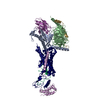
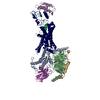
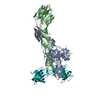
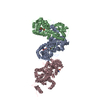
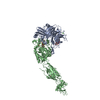
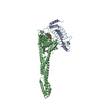
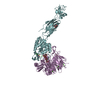
 PDBj
PDBj




















